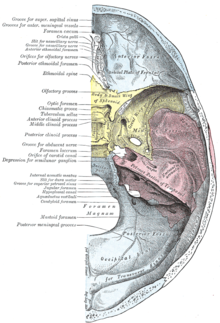Human Anatomy/Osteology/Skull


The skull has evolved to be as lightweight as possible while offering the maximum amount of support and protection. In order to be light, the skull is made up by flat and irregular bones, and has hollow spaces called the sinuses. It offers protection to the brain, eye balls, inner ears, and nasal passages.
The human skull can be divided into two sections, the cranium and the face. In most people, the cranium is made up of 8 bones and the face is made up of 14. Often, the ossicles of the ear and the hyoid bone are counted as part of the skull, giving the normal human skull 29 bones (it should be noted that variations are not necessarily abnormal).
Cranium[edit | edit source]
The cranium's main function is toprotect the brain from trauma. The bones of the cranium are joined by sutures, which look like jagged lines across the cranium's surface. These joints fuse as a person matures. There are four major sutures:
- Sagittal Suture- the joint between the two parietal bones.
- Coronal Suture- the joint between the frontal bone and the parietal bones.
- Squamous Suture- the joint between the parietal and temporal bones.
- Lambdoidal Suture- the joint between the parietal bones and the occipital bone.
The last of these sutures to fuse is the coronal.
Development[edit | edit source]
The coronal suture eventuallywill covers the infant's frontal fontanelle, a membranous area between the bones of the skull. Fontanelle allow the child's head to be more pliable during birth to allow for an easier delivery. They also allow for the accelerated growth of the human brain in the first years of life. In the newborn child, there are a total of 6 fontanelle:
- Frontal- at the intersection of the parietal bones and the frontal bone.
- Occipital- at the intersection of the parietal bones and the occipital bone.
- Mastoid (2)- at the intersection of the parietal, occipital, and temporal bone on either side of the head.
- Sphenoidal (2)- at the intersection of the parietal, temporal, frontal, and sphenoid bones on either side of the head.
The occipital and sphenoidal fontanelle (being the smaller of the six) close between the second and third months after birth. The mastoid usually fills in around a year after birth. And the frontal, which is the largest, generally takes between 18 and 24 months to close.
Bones of the Cranium[edit | edit source]

The calvaria, or the top hemisphere of the cranium is made up of the squamous bones, the superior part of the frontal bone, the parietal bones, and the superior part of the occipital bone.
The base of the cranium consists of the ethmoid, sphenoid, and occipital bones. There are three distinct regions in the base of the cranium which can be seen from above with the calvaria removed. These are called fossae and are named by their position with respect to the body: anterior, middle, and posterior fossae. The base of the cranium has several holes called foramina (singular, foramen) which allow blood vessels and nerves to enter and leave the cranium.
Foramen and Canals[edit | edit source]
The largest, most obvious foramen is located at the base of the occipital bone. It is named the foramen Magnum. The spinal cord passes through this large opening and connects to the brain at the Medulla Oblongata. Just lateral to the foramen Magnum are the much smaller Hypoglossal canals which provide a passageway for the Hypoglossal nerves. Beyond the Hypoglossal canals, at the junction of the Occipital bone with the temporal bones are the Jugular foramina. These are all found in the posterior fossa.